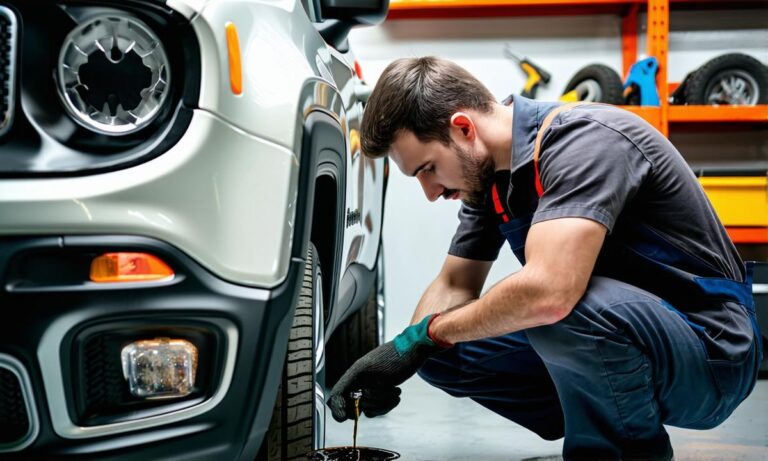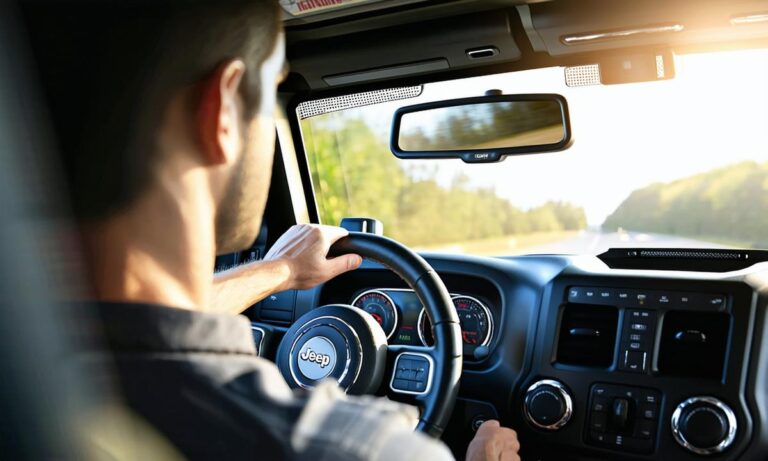Do I Need To Lift My Jeep For 33 Inch Tires? Is It Necessary?
Lifting your Jeep serves various purposes, whether enhancing its off-road capabilities or boosting its visual appeal. Numerous factors impact your vehicle’s ride quality, safety, and potential maintenance requirements, making informed decisions vital. But how high is high enough? Or do you even need it for 33 inch tires.
Actually no, lifting your Jeep isn’t mandatory for 33-inch tires, but it’s common for optimal clearance. A 2- 3-inch lift kit is recommended, though some succeed with a 1.5- inch lift, or a combination lift of 2.5-inches suspension and 1.25 inches body.
However, to get the whole grasp about the matter, you may want to go to this comprehensive guide. You can discover if a lift kit is necessary, the ideal lift size, and key considerations for optimal performance. So, read on.
Key Takeaway:
- Upgrading to 33-inch tires on a stock Jeep is possible but may require considerations like potential rubbing issues.
- A 2-3-inch lift kit is recommended for accommodating 33-inch tires on a Jeep, ensuring optimal performance and clearance.”
- Proper research, consultation, and planning ensure a satisfying Jeep experience, whether for aesthetics, off-roading, or daily driving.
Do I Need A Lift Kit For My Jeep?
Whether you need a lift kit for your Jeep depends on your driving preferences, intended use, and desired modifications. Here are some factors to consider when deciding if a lift kit is right for you:
1# Off-Road Capability:
If you plan to take your Jeep off-road frequently or tackle more challenging terrain, a lift kit can significantly improve its performance.
Lifted suspension provides increased ground clearance, allowing you to navigate over obstacles without damaging the undercarriage.
2# Tire Size:
Lift kits are often necessary if you want to install larger tires on your Jeep. Larger tires can improve traction, ground clearance, and overall aesthetics.
But they may rub against the fenders or suspension components without adequate lift.
3# Appearance:
Some Jeep owners opt for lift kits purely for aesthetic reasons. A lifted Jeep typically has a more aggressive stance and a commanding presence on the road, which appeals to many enthusiasts.
4# Customization:
Lift kits offer the flexibility to customize your Jeep according to your preferences.
Whether you want to create a rugged off-road machine or a lifted showpiece, a lift kit provides the foundation for endless customization options.
5# Budget and Practicality:
Lift kits can be a significant investment, considering the cost of the kit itself, installation, and any additional modifications required.
Consider your budget and whether the benefits of a lift kit align with your driving needs and priorities.
Can I Put 33 Inch Tires On My Jeep Without A Lift?
You can absolutely put 33-inch tires on your Jeep without lifting it. They fit well on non-lifted stock models like the four-door Sport Sahara and Rubicon JLs.
This setup is great for everyday driving and light off-roading on trails. However, be aware that the tires might rub slightly, especially at full turn, due to their larger size. This is more likely if you’re using stock rims, especially if they’re narrower.
Opting for rims around 15 or 16 inches in width can help accommodate 33-inch tires more comfortably, minimizing rubbing issues.
So, while you can do it without a lift, just keep in mind these considerations for a smoother ride.
What Size Lift Do You Need For 33 Inch Tires On A Jeep?
While it’s possible to fit 33-inch tires on a Jeep without a lift, using a lift kit is more common for optimal performance and clearance.
For most Jeep models, a 2–3 inch suspension lift is recommended to accommodate 33-inch tires comfortably.
This lift provides the necessary clearance for the larger tires, reducing the risk of rubbing, especially during off-road adventures.
Some Jeep owners have successfully used smaller lifts, such as a 1.5 inch suspension lift, to fit 33-inch tires. According to them 1.5 inch suspension will be enough to fit the 33 inch tires in the jeeps.
However, this may result in tighter clearance and potential rubbing, particularly in rugged off-road conditions.
Moreover, for those seeking additional clearance and versatility, a combination of a 2.5 inch suspension lift and a 1.25 inch body lift is often suggested.
This setup not only provides ample space for 33-inch tires but also helps prevent damage to the fenders when navigating challenging terrain.
The addition of a body lift can offer extra clearance, preventing the tires from damaging the fenders when fully compressed, a common concern when tackling rough terrain.
Ultimately, the size of the lift needed depends on factors such as your Jeep model, desired tire size, and intended off-road use. It’s essential to consider these factors carefully to ensure proper fitment and optimal performance.
Additionally, keep in mind that installing a lift kit requires careful attention to detail and may involve other modifications such as adjusting steering geometry and installing longer shocks.
Lift According To The Size Of The Tires
Choosing the right lift size for your Jeep based on tire size is crucial for achieving optimal performance both on and off the road. Follow it with the chart we provided, detailing the recommended lift sizes for various tire sizes.
This introduction sets the stage for the chart and emphasizes the importance of selecting the correct lift size for your Jeep’s tire size.
| Tire size | Lift |
| 33 ” tire | 2–3″ lift kit |
| 35 ” tire | 2.5″-3″ lift kit |
| 37 ” tire | 4″ lift for off-road |
| 38 ” tire | A lift of 6 inches or more |
| 40 ” tire | 6″ lift unless you do some major body modifications |
What Size Lift Is Best For A Jeep?
Determining the best lift size for a Jeep depends on several factors, including the model of your Jeep, your intended use, tire size, and personal preferences. Here’s a comprehensive guide to help you choose the right lift size:
1# Stock Suspension:
If you’re driving a Jeep with stock suspension and are looking to enhance its off-road capabilities, a modest lift of 2–3 inches is a popular choice.
This lift provides enough clearance for larger tires and improves ground clearance without drastically altering the vehicle’s handling characteristics.
2# Tire Size:
Consider the size of the tires you plan to install. As a general rule of thumb, larger tires require more lift to accommodate them properly.
For example, if you’re upgrading to 33-inch tires, a 2–3 inch lift is sufficient.
However, for 35-inch tires, you may need a lift kit ranging from 2.5 to 4 inches, depending on your Jeep model and intended use.
3# Off-Road vs. On-Road Performance:
Determine whether your Jeep will primarily be used for off-roading or on-road driving. A higher lift, such as 4 inches or more, is beneficial for serious off-roading enthusiasts tackling challenging terrain with larger obstacles.
However, if your Jeep is mainly used for daily commuting or light trail riding, a smaller lift of 2–3 inches may be more suitable.
4# Budget and Practicality:
Consider your budget and practicality when choosing a lift size. While larger lifts offer more ground clearance and off-road capability, they often come with a higher price tag and may require additional modifications.
A smaller lift may be more budget-friendly and easier to install, making it a practical choice for casual off-roaders.
How Big Of Tires Can I Fit Without A Lift?
Without a lift, you can typically fit tires up to 33 inches in diameter on your Jeep. However, the width of the tire can pose clearance issues, especially if your vehicle remains at stock height.
In particular, the wider tires may rub against suspension parts, inner fenders, or end links, potentially causing damage and compromising performance.
Some Jeep enthusiasts suggest that for off-roading purposes, the largest tire you should run without a lift is 31×10.5 inches to avoid rubbing and other issues.
However, if you’re looking to go bigger than 31-inch tires, many experts recommend investing in a lift kit.
A lift of 2–2.5 inches provides additional clearance, allowing for the installation of 33-inch tires without significant rubbing or clearance concerns.
It’s essential to consider your Jeep’s intended use and driving conditions when deciding on tire size and lift requirements.
While it’s possible to fit larger tires without a lift, doing so may compromise your vehicle’s performance and durability, particularly in off-road environments where clearance and articulation are crucial.
FAQs
At this point of the discussion, check out some mostly asked queries by the jeep owners to learn more about the matter.
Can you put 33 inch tires on a stock Jeep?
Yes, you can put 33-inch tires on a stock Jeep, but there may be slight rubbing at full turn due to the larger size. Consider wheel width and backspacing to minimize rubbing issues.
What is the biggest size tire you can put on a stock Jeep?
The biggest size tire you can put on a stock Jeep varies, but typically it’s around 33 inches without modifications. Consider upgrading to a lift kit for larger tires.
Can I put 35 inch tires on my Jeep without a lift?
It’s possible to put 35-inch tires on a Jeep without a lift, but it may cause rubbing and clearance issues, especially during off-roading. Opting for narrower tires can help mitigate these problems.
Does lifting a Jeep affect gas mileage?
Lifting a Jeep can affect gas mileage slightly due to increased aerodynamic drag and added weight from larger tires and suspension components. However, the impact is generally minimal.
What size tire can I fit on my Jeep?
The size of tire you can fit on your Jeep depends on factors like the model, wheel size, and suspension setup, but typically ranges from stock size to 35 inches with a lift. Consider consulting with an expert for specific recommendations.



